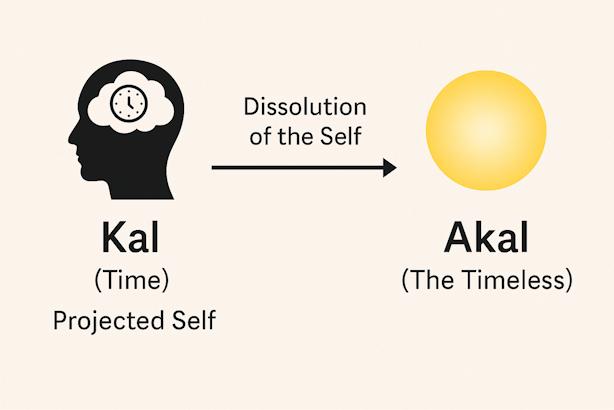“Sikhism is the path of direct perception of the timeless reality (Akal) by dissolving the projected self.”

Most people know “Sat Sri Akal” as a Sikh greeting, but few realise that its meaning opens into one of the purest spiritual insights ever articulated. Sikhism was never meant to be a belief system. It was built on direct perception — seeing reality as it is, without the interference of the self. At the centre of this vision stands a single word: A-Kal. It does not mean eternal in the sense of living forever. It means beyond time altogether, the silent field that exists before birth, before identity, before thought. When Guru Nanak returned from his three days in the river, he did not return with a doctrine; he returned with a perception. And through that perception he pointed to what the mind becomes when the self dissolves and the timeless reveals itself. This article enters that space, not through belief, but through the doorway of direct seeing.
Sikhism begins where belief ends. It does not ask you to imagine a God, accept a doctrine, or inherit a tradition. It asks only one thing: to perceive the truth directly. This direct perception — this raw encounter with reality before thought, time, and identity intervene — is the living heart of Sikh philosophy. And the clearest name it gives to that truth is A-Kal: the One beyond time.
A-Kal is not eternity stretched out forever. It is not immortality and it is not the survival of the soul. A-Kal is something far more radical: the disappearance of time itself, the vanishing of the mental structure that creates birth, becoming, decay, and death. A-Kal is the centre before the projected self arises, the silent field from which all forms emerge, and the place to which all forms return.
Guru Nanak’s awakening in the river Bein was not a moment of belief. It was a rupture of perception. For three days he disappeared into the waters, and what returned was not the man he had been but one who had seen — seen directly that the divisions of Hindu and Muslim were creations of the mind, not of reality. This was not a theological insight. It was a moment when the projected self dissolved and the timeless field revealed itself.
This is why the Mul Mantar opens not with a story but with an ontological statement: Ik Onkar. Satnam. Karta Purakh. Nirbhau. Nirvair. A-Kal Murat. These are not descriptions of a distant deity. They are the qualities that appear in direct perception when the mind becomes silent and the self falls away. The Gurus were mapping the structure of reality as it is seen when the observer disappears.
Sikhism rejects all indirect routes — rituals, intermediaries, superstitions — because indirect perception always strengthens the projected self. A person who performs rituals is not seeing truth. A person who repeats beliefs is not seeing truth. For Sikhism, truth is neither inherited nor imagined. It is encountered directly when the mind stops projecting its own illusions.
This is why Naam Simran is often misunderstood. It is not repetition of a name; it is the quieting of the mind until the deeper field reveals itself. When memory and anticipation fade, when the machinery of the self no longer binds the mind to time, the presence of A-Kal appears — not as a belief but as a fact of perception. The Gurus used the word Anubhav, meaning direct experiential knowing. Without this direct perception, the scriptures say, nothing is truly known.
The entire Guru Granth Sahib is a map of this transition — from the projected self trapped in Kal (time, causation, decay) to the recognition of the centre that is A-Kal (timeless, unborn, uncreated). Every metaphor and every line points back to the same realisation: truth is not found by extending the self, purifying the self, or perfecting the self, but by dissolving the self. What remains when thought falls silent is the Timeless One, the field without beginning or end.
This is why the Sikh greeting, Sat Sri Akal, is not a casual hello. It is a reminder spoken to another being: the truth in you is not time-bound. The truth in you is A-Kal. Beneath identity, beneath the personality, beneath the story of life and death, one’s nature can be the same timeless presence the Gurus touched in their awakening. The greeting itself is an instruction — return to the centre, where you see through the illusion of the projected self.
In this sense, Sikhism is not a religion in the traditional sense. It is a practice of direct perception. It is a path that takes you from mental projection to unmediated seeing, from time to timelessness, from thought to silence, from the self to the One. When the projected self dissolves, what appears is not a new identity but the truth that was always there: A-Kal, the timeless reality that contains all things and yet is untouched by time.
The Gurus did not ask us to believe in A-Kal. They asked us to become silent enough to perceive it. Sikhism leads the mind out of time and into A-Kal, the silent field that appears when the self disappears.
